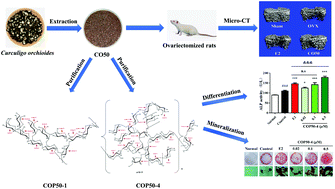Structural characterization and anti-osteoporosis activity of two polysaccharides extracted from the rhizome of Curculigo orchioides†
Abstract
Curculigo orchioides is widely used to treat osteoporosis in China. In this study, we identified the active substances in the crude polysaccharide (CO50) from C. orchioides that had anti-osteoporosis activity in vivo. Two polysaccharides, COP50-1 and COP50-4, were purified from CO50. Based on structural analysis, COP50-1 was composed of α-D-Glcp-(1→, β-D-Galp-(1→, →4)-α-D-Glcp-(1→, →3,4)-α-D-Glcp-(1→, →4,6)-α-D-Glcp-(1→, →4,6)-β-D-Manp-(1→, whereas COP50-4 was composed of α-L-Araf-(1→, →2)-α-L-Rhap-(1→, β-D-Manp-(1→, α-D-Galp-(1→, →2,4)-α-L-Rhap-(1→, →2)-β-D-Manp-(1→, →4)-α-D-GlcAp-(1→, →3)-α-D-GalAp-(1→, →4,6)-α-D-Galp-(1→, →2,3,6)-β-D-Manp-(1→, →2,3,5)-α-L-Araf-(1→, →2,5)-α-L-Araf-(1→, →4)-α-D-Glcp-(1→ and →3)-α-D-Galp-(1→. Pharmacological assessment revealed that COP50-1 had no obvious osteogenic activity. However, COP50-4 (0.5 μM) significantly enhanced the differentiation and mineralization of osteoblasts in vitro. Moreover, the effect of COP50-4 was greater than that of 17β-estradiol. Therefore, COP50-4 may be an effective component of CO50 that has great potential for development as an alternative drug for the treatment of osteoporosis.



 Please wait while we load your content...
Please wait while we load your content...